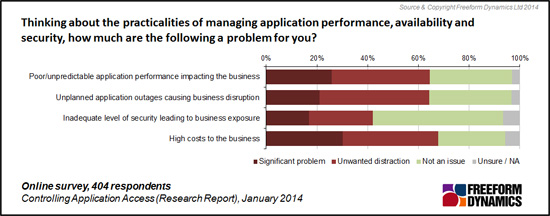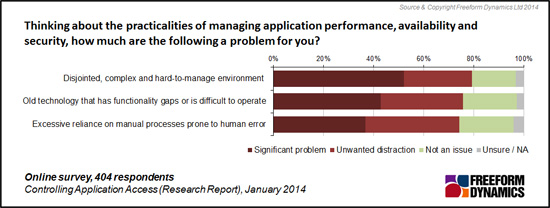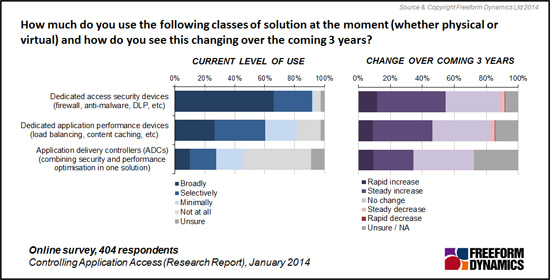By Tony Lock
Originally published for the channel
A recent survey by Freeform Dynamics revealed significant challenges with the state of the networks used by your customers to support their everyday business applications. This state of affairs is probably representative of many of your client’s networks, namely that they are a mess for wholly understandable reasons. There is a clear opportunity for you to help your customers clean things up and modernize networking capabilities.
To begin with, the survey shows that many of your customers’ organisations have networks built from equipment of varying ages and capabilities. These severely test the ability to meet the rapidly changing demands for application availability, performance and security that your clients are undergoing. In particular the channel has the opportunity to help customers update their networking security and performance capabilities in line with escalating user expectations and changing working patterns, especially to handle escalating demands for mobile and remote access.
With this in mind, a majority of organisations surveyed, your customers, indicate they have either significant problems or unwanted distractions in many areas that directly impact on business operations (Figure 1).
Figure 1
As can be seen, many of your customers indicate they have problems with poor or unpredictable application performance that directly impact the business. Almost as many acknowledge application outages are occurring that are directly disrupting business operations.
However these manifest themselves, nearly two out of every three of your customers recognise that inadequate application delivery control is leading to high costs, something no organisation accepts with equanimity. Parts of these costs will be a direct consequence of increasing overheads and IT operations, but perhaps even more significant costs may accrue indirectly as a consequence of lost business, or reduced staff productivity.
With this in mind, the survey also probed what factors in existing application access and security networks your customers identify as causing them problems (Figure 2).
Figure 2
Over three quarters of your customers are likely have problems running networks that are disjointed, complex or hard to manage. Similar numbers will also be using old networking technology that probably has functionality gaps or that is difficult to operate. These problems are serious enough, but the fact that almost as many customers state they have excessive dependence on manual processes prone to human error highlights another opportunity for you to get involved.
Beyond the basic challenges already mentioned, significant numbers of customers state the pressures on their networks are likely to grow in the near future. In particular many recognise that changing work and access patterns amongst staff, customers and partners are already adding to security and performance problems.
Indeed, the security challenges are also being stressed by advances in the nature of the internal IT infrastructure, most particularly the rapid uptake of virtualisation to deliver key business services. In particular, there is a widespread recognition that the way security is handled needs to change.
There is a widespread recognition amongst IT professionals that securing the enterprise network perimeter alone is no longer good enough to ensure data and systems are adequately protected. A majority of those taking part in the survey state moving to a security strategy based on a data/system centric approach is desirable, yet very few have managed the transition. This is another area where channel partners have the opportunity to help customers adapt their network infrastructures.
One possible approach that some organisations might take to improve the security, performance and availability capabilities of their networks could be to combine various components into a single device type. However, figure 3 shows that only a small minority are currently utilising Application Delivery Controller solutions that simplify networks.
Figure 3
At the highest level, the picture is consistent with the mainstream market for ADCs being quite new, and knowledge and awareness being relatively limited. The research confirms the existence of a perception and awareness gap to do with ADCs versus traditional networking kit. This is especially clear when comparing the assessment of potential benefits deliverable through the use of ADCs between those with significant experience of the solution type and those with none. Those with experience of ADCs give a positive picture of the rationale for converged/integrated devices, but much of the free-text commentary received from respondents expressed a degree of scepticism or concern on the use of such solutions.
The research clearly indicates that the networks deployed in many organisations are already under considerable stress and organisations expect they will need to update things, but few have solid plans on how to change. Opportunities clearly exist for channel partners able to explain how network infrastructures can be modernised. But IT professionals also need help to explain to budget holders the potential business benefits that can be delivered in order to make a solid business case for investment.
A combination of access, performance and security concerns coupled with an acceptance that the costs of managing existing networks are too high may be enough to trigger action now rather than wait. This is your opportunity to get into your customers and help them make things better, more secure and ready to handle new working patterns. Are you ready to sell better networking capabilities that help the business operations of your customers? The full report shows you ways to start conversations with your customers.

Registration required
Tony is an IT operations guru. As an ex-IT manager with an insatiable thirst for knowledge, his extensive vendor briefing agenda makes him one of the most well informed analysts in the industry, particularly on the diversity of solutions and approaches available to tackle key operational requirements. If you are a vendor talking about a new offering, be very careful about describing it to Tony as ‘unique’, because if it isn’t, he’ll probably know.








Have You Read This?
From Barcode Scanning to Smart Data Capture
Beyond the Barcode: Smart Data Capture
The Evolving Role of Converged Infrastructure in Modern IT
Evaluating the Potential of Hyper-Converged Storage
Kubernetes as an enterprise multi-cloud enabler
A CX perspective on the Contact Centre
Automation of SAP Master Data Management
Tackling the software skills crunch